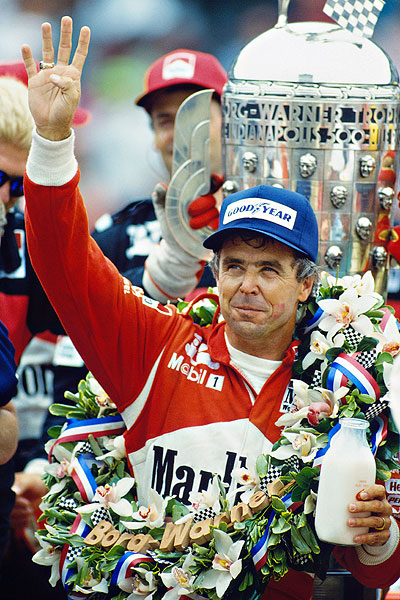I could spend years talking about the greatness of Rick Mears, in my mind the greatest to ever race at the Brickyard. With how skilled the great Mears was, he needed what every other driver at Indy needs: good timing and a bit of luck on his side.
With so many years of great Mears stories, we’ll focus just on Mears’s four victories at Indianapolis.
We start in 1979 where Mears qualified on pole, nearly a full mph faster than second place Tom Sneva (who always ended up second in the race…at least he won once in 1983, but I digress…). Mears quickly gives up the lead to Al Unser. Unser and his brother Bobby exchange the lead for a combined 174 laps, but Mears leads the last 28 laps (minus a couple during cycling pit stops) after Al leaves on lap 104 with a fire and Bobby loses his top gear and has to reduce speed to stay on track.
Finishing fifth (1980), third (1983), and second (in the closest finish to date 1982, losing to Gordon Johncock by 0.16 seconds), he just couldn’t quite get back to victory lane. In 1981 he was leading on lap 58 when he came in for a pit stop, but his car caught fire when fuel hit the hot engine, knocking him out of the race and preventing possibly his second race that year. He led at least one lap in each of those races.
He set the record in 1984 by leading his sixth race in a row when he takes the lead at the green flag over polesitter Tom Sneva and Howdy Holmes. Lots of action up front ensues between the Andretti’s of Mario and Michael, Sneva, and Mears. As the race ensues, each of the three chasers eventually fall out of contention, allowing Mears to (finally) get his second Indy victory. He leads 119 laps.
Another pole in ’86 put Mears in contention yet again, but falls just short (3rd place in the closest 1-2-3 finish to date). He starts on the front row again in ’87 but has car trouble. The one thing about Mears, he either was in contention at the end or something broke on his car. He never crashed. He never made a mistake on the track. Ever.
 Mears showed pure speed in 1988 when he posted a 219.198 mph qualifying speed, and shattering the single lap speed by going 220+ mph. He is just shy of 3 mph faster than his teammate Johnny Rutherford. On race day, though, it’s a day full of carnage and trouble. 14 cautions mar the race as a whole, and throughout the 500 miles, Mears battles a terribly mishandling car. He was nearly two laps down early in the race, yet on lap 113 he takes the lead from his teammate Al Unser. He stayed patient throughout the race, took his time, and let his team fix the handling issues with the plethora of cautions. He cruises to his third victory, one in which Team Penske leads 192 of the 200 laps.
Mears showed pure speed in 1988 when he posted a 219.198 mph qualifying speed, and shattering the single lap speed by going 220+ mph. He is just shy of 3 mph faster than his teammate Johnny Rutherford. On race day, though, it’s a day full of carnage and trouble. 14 cautions mar the race as a whole, and throughout the 500 miles, Mears battles a terribly mishandling car. He was nearly two laps down early in the race, yet on lap 113 he takes the lead from his teammate Al Unser. He stayed patient throughout the race, took his time, and let his team fix the handling issues with the plethora of cautions. He cruises to his third victory, one in which Team Penske leads 192 of the 200 laps. ’89, pole position. ’90, middle of row one. ’91, pole position. Always fast in his Penske machine, he finally pulls off his fourth Indy victory in 1991. He runs laps over 221 mph down the stretch to pull away by three seconds over up-and-coming Michael Andretti. He joins A.J. Foyt and Al Unser as four-time winners at Indy.
It took Foyt 20 years to get four Indy 500 victories. It took Al Unser 22 years. Rick Mears did it in just 14 years. He was the most consistent racer you will probably ever see at any level. If his car held on, then he was fighting for the win. Plain and simple, Rick Mears was a force to be reckoned with at the greatest racetrack in the world.







No comments:
Post a Comment
We love to hear your feedback! This site is created by the fans and for the fans. But please, keep it clean. Any lewd, obscene, or irrelevant comments will be removed immediately.